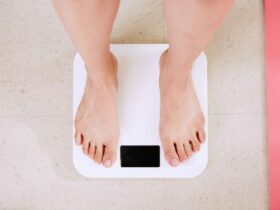There are a lot of diet regimens for losing weight available online. But there isn’t much to be found for weight growth! In fact, you won’t find many programs for gaining weight. However, a sizeable portion of individuals battle with their bony fame and fall short of gaining the required heft.
Being underweight or thin might indicate a deeper problem. You become underweight when you consume too few calories over an extended period of time, which may cause a variety of ailments. On the other hand, consuming too many calories might lead to weight gain, which is equally unfavorable.
The math for weight gain is very straightforward since you eat more calories than you expend. You need to eat more calories to satisfy your body’s needs if your metabolism is high or you exercise vigorously. Gaining weight cannot be accomplished only by consuming. But among the strategies to gain weight naturally include eating five to six times each day, consuming more protein and fat, and including high-calorie snacks.
Without doing enough research, people use numerous pills and eat unhealthily to gain weight rapidly. Think cautiously before consuming anything since they might cause them to have health issues. Eat wholesome meals that help you gain power and muscle instead. Following are a few suggestions for nutritious meals that you should consume if you’re aiming to gain weight.
How Can I Gain Weight Healthily?

The basic idea is to eat more calories during the day than you expend, as was already indicated. You may strive to eat 300–500 calories more than you need as a general rule. A further general suggestion is to increase the number of meals you consume each day rather than their amount. When attempting to gain weight, increasing your dietary intake of protein and fats is practically required. Consuming junk food and bad fats in an attempt to gain weight is one thing you shouldn’t do. These meals will simply make you gain weight around your middle and may eventually lead to major long-term problems including diabetes, obesity, and heart problems. Additionally, it is a good idea to add regular, but not strenuous, exercise into your daily schedule in order to increase your muscle mass.
Regardless of your weight, it’s crucial to eat nutrient-dense meals. For optimum nutrition, the U.S. Department of Agriculture (USDA) advises include a range of healthy foods in your diet, such as protein, fruit, vegetables, grains, and dairy products.
On Nutrition Facts labels, the U.S. Food and Drug Administration (FDA) uses a 2,000-calorie diet as an example. The guideline to take 2,000 calories is not always valid. Your body may need a different quantity of calories depending on your age, sex, and degree of exercise.
You should normally eat an extra 500 calories each day if you’re underweight. You might eat more meals or make your regular meals larger to achieve this. By include healthy monounsaturated and polyunsaturated fats like those found in avocado, nuts, seeds, and plant-based oils, you may also boost calories and fats.
You’ll probably benefit from snacking on little, calorie-dense meals and treats throughout the day if you don’t have a big appetite. If you don’t have enough time to prepare extra snacks, you may just consume larger portions of the meals you normally eat.
Although reaching for a bag of salty chips or a tub of sweet ice cream may seem like an easy option since these foods are high in calories, they are low in nutritious value. You may experience bloating and fatigue after consuming foods high in salt and sugar. Additionally, routinely and excessively ingesting certain foods may raise your risk of cardiovascular disease and type 2 diabetes.
Although processed meals are often linked to weight gain and obesity, they may also cause autoimmune illnesses, colon cancer, inflammatory bowel disease (IBD), and mood disorders including anxiety and depression.
Instead, begin a healthy weight-gaining diet by following the advice in the following paragraphs to consume more nutrient-rich meals.
Tip #1: Use an extra egg and add more cheese to your omelet
Use an extra egg and add more cheese to your omelet.
Omelets often include two or three eggs, some cheese, and several other ingredients, thus they are already high in energy. Use a bit more cheese and an additional egg in your omelet to up the calorie count. However, save some space for some wholesome vegetables, such as spinach, peppers, and onions, or even some mushrooms and tomatoes.

Use a spoonful of avocado oil or extra virgin olive oil to cook your omelet. This will increase the amount of monounsaturated fat and calories. For even more calories and more creaminess, you may also add a little amount of whole milk or half-and-half to the egg mixture. For a substantial serving of healthful fat, serve a piece of whole-grain bread with avocado on the side.
Tips #2: Eat more of the starchy vegetables, such potatoes, in larger portions
Eat more of the starchy vegetables, such potatoes, in larger portions.
Despite the fact that your body requires carbohydrates for energy and that potatoes are strong in vitamins, minerals, and fiber, potatoes often receive a poor name due to their high carbohydrate content. Add yogurt or sour cream to enhance the calories, and extra points if you cook with good fats like olive oil.
Due to their starchiness, potatoes have more calories than green vegetables. You should feel free to eat a lot of potatoes, sweet potatoes, butternut squash, winter squash, and even sweet corn even if you don’t want to stop eating Brussels sprouts, broccoli, and kale.
Tips #3: Have an extra slice of whole grain toast with peanut butter for breakfast per tip three
Have an extra slice of whole grain toast with peanut butter for breakfast per tip three.
Start your day off well with a full breakfast and a few extra slices of whole-grain bread spread with peanut butter, which is heavy in calories, fat, and protein. About 200 calories are included in two tablespoons of peanut butter. 16 Choose natural peanut butter over those with added sugar. Since they are high in protein and healthy fats, almond butter and other nut and seed butters are also good options for gaining weight.

Dietary fiber may be obtained from whole grains. Pick a piece of whole-grain bread that has at least 100 calories. A loaf of bread will often have more calories and good fats per serving if it includes nuts and seeds.
The top whole grain breads have been tried, tested, and evaluated by us. Investigate your options if whole grain breads are what you’re seeking.
Tips #4: Drink whole milk, 100% fruit juice, or vegetable juice as your fourth tip
Drink whole milk, 100% fruit juice, or vegetable juice as your fourth tip.
For more protein, calcium, and vitamin D, sip a glass of whole milk with your nut butter toast. Choose a nut-based milk substitute if you don’t like or don’t want to drink cow’s milk. Although it won’t be as calorie-dense, it should still be supplemented with calcium and vitamin D, which are crucial minerals for weight growth.
Choose 100% fruit and vegetable juices throughout the day that don’t include any extras like sugar. To be sure you’re eating actual, simple-to-pronounce foods, carefully read the Nutrition Facts labels—the fewer ingredients stated, the better.

While heavy in calories and appealing, sugary drinks don’t provide any additional nourishment. They include a lot of added sugar, which is associated with a higher risk of developing chronic diseases.
To increase your daily intake of vitamins and minerals, pick whole milk or fruit and vegetable juices when it comes to drinks.
Tips #5: Top yogurt with chopped nuts, oats, fruit, and honey
Add liberal amounts of walnuts, almonds, or pecans to your Greek yogurt along with your preferred dried fruit, oats, or granola. You may finish it off with a tablespoon of honey for a tasty and nutritious snack or dessert.
Yogurt has helpful bacteria that support digestive health, while nuts include calories that are necessary for weight growth as well as healthy fats.
Tips #6: Use Protein Bars to Increase Protein Intake (and Calories)
In terms of ingredients, protein bars are comparable to trail mix. Protein bars may be made at home or bought at any supermarket or convenience shop in any quantity. To find out how many calories you’re receiving per serving and if it fits the criteria for your weight-gaining plan, look at the Nutrition Facts label. Watch out for unmarked additional sugars as well.
Tips #7: Carry a bag of trail mix for an easy snack, tip number seven
A combination of nuts, seeds, cereal, and dried fruit is called trail mix. In supermarket shops, you may purchase trail mix or prepare your own. In fact, adding chocolate chips will add a few more calories. To have something to snack on while on your weight-gaining diet, keep your trail mix in a plastic bag or container and take it with you everywhere you go.
Tips #8: Eat red meat, tip eight (and Choose Lean Cuts for a Healthy Heart)
Despite having more calories than leaner cuts of meat, eating too much of them raises your chance of developing heart disease.
19 Make careful to consume fatty red meat in moderation if you decide to include it in your diet to gain weight.
Bison, lean ground beef, and lean steak are all excellent choices that yet provide a lot of nutrients for healthy bodily function.
20 If you don’t consume red meat, you can still get enough protein from other sources such as poultry, pork, fish, and even plant-based foods like soy products and lentils.
There are several options to make sure you receive enough protein when on a diet to gain weight, whether you choose for lean animal protein or sources from plants.
Tips #9: Add an egg to your avocado toast
Since they are an excellent source of protein, healthy fat, and fiber, avocados are regarded as a superfood. They are a terrific addition to a diet plan for gaining weight. Add a fried or poached egg to your avocado toast for a double serving of protein and extra calories.
Tips #10: Use sour cream as a standard topping
Along with the additional calories required for a healthy weight increase, sour cream also offers calcium. Cheese, gravy, full-fat Greek yogurt, and grass-fed butter are additional sources of calories.










Leave a Review